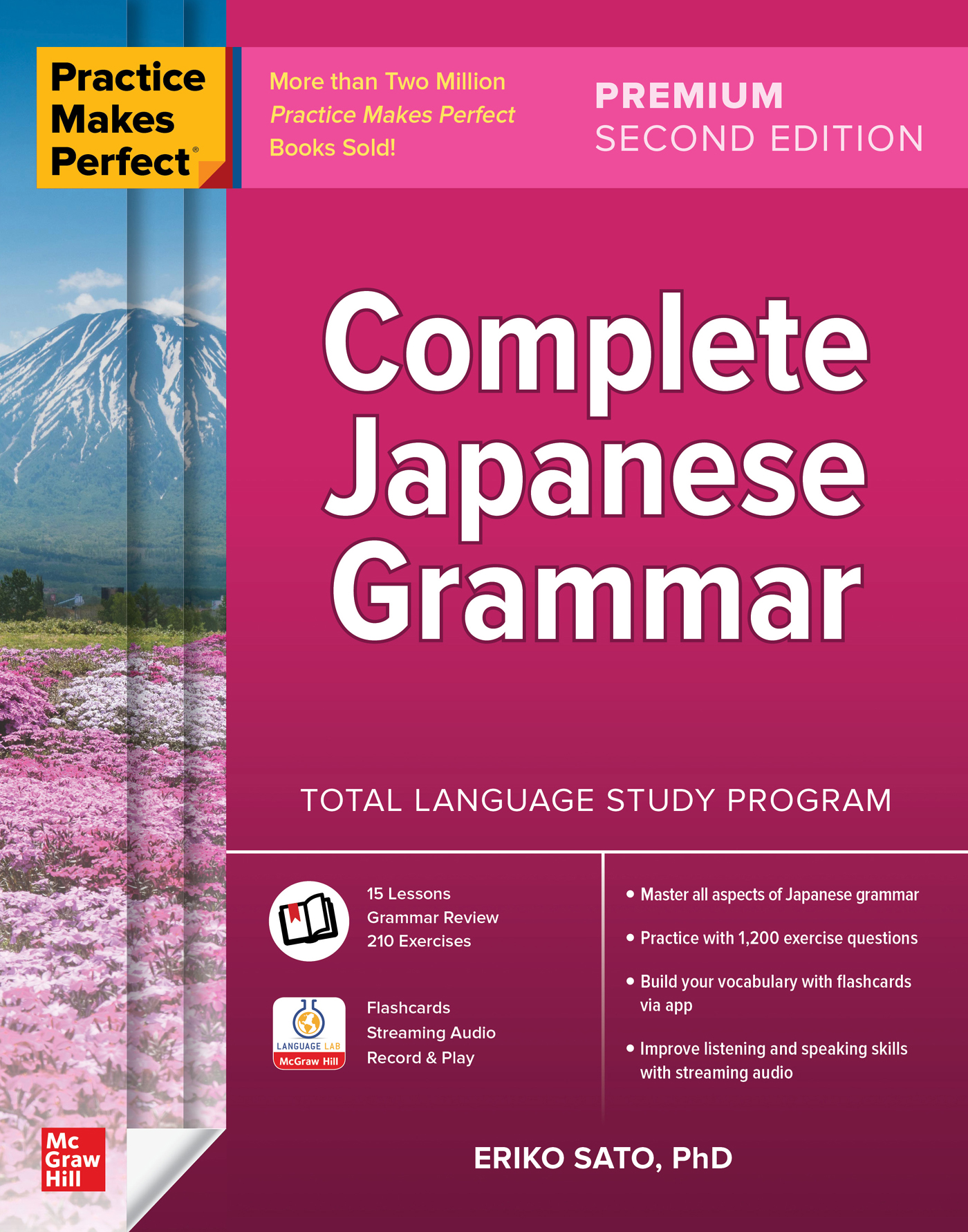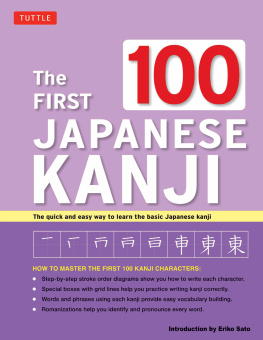Eriko Sato - Practice Makes Perfect: Complete Japanese Grammar
Here you can read online Eriko Sato - Practice Makes Perfect: Complete Japanese Grammar full text of the book (entire story) in english for free. Download pdf and epub, get meaning, cover and reviews about this ebook. year: 2021, publisher: McGraw-Hill Education, genre: Children. Description of the work, (preface) as well as reviews are available. Best literature library LitArk.com created for fans of good reading and offers a wide selection of genres:
Romance novel
Science fiction
Adventure
Detective
Science
History
Home and family
Prose
Art
Politics
Computer
Non-fiction
Religion
Business
Children
Humor
Choose a favorite category and find really read worthwhile books. Enjoy immersion in the world of imagination, feel the emotions of the characters or learn something new for yourself, make an fascinating discovery.

- Book:Practice Makes Perfect: Complete Japanese Grammar
- Author:
- Publisher:McGraw-Hill Education
- Genre:
- Year:2021
- Rating:5 / 5
- Favourites:Add to favourites
- Your mark:
- 100
- 1
- 2
- 3
- 4
- 5
Practice Makes Perfect: Complete Japanese Grammar: summary, description and annotation
We offer to read an annotation, description, summary or preface (depends on what the author of the book "Practice Makes Perfect: Complete Japanese Grammar" wrote himself). If you haven't found the necessary information about the book — write in the comments, we will try to find it.
Practice Makes Perfect: Complete Japanese Grammar — read online for free the complete book (whole text) full work
Below is the text of the book, divided by pages. System saving the place of the last page read, allows you to conveniently read the book "Practice Makes Perfect: Complete Japanese Grammar" online for free, without having to search again every time where you left off. Put a bookmark, and you can go to the page where you finished reading at any time.
Font size:
Interval:
Bookmark:

 Copyright 2021 by McGraw Hill. All rights reserved. Except as permitted under the United States Copyright Act of 1976, no part of this publication may be reproduced or distributed in any form or by any means, or stored in a database or retrieval system, without the prior written permission of the publisher. ISBN: 978-1-26-046322-4
Copyright 2021 by McGraw Hill. All rights reserved. Except as permitted under the United States Copyright Act of 1976, no part of this publication may be reproduced or distributed in any form or by any means, or stored in a database or retrieval system, without the prior written permission of the publisher. ISBN: 978-1-26-046322-4MHID: 1-26-046322-2 The material in this eBook also appears in the print version of this title: ISBN: 978-1-26-046321-7, MHID: 1-26-046321-4. eBook conversion by codeMantra
Version 1.0 All trademarks are trademarks of their respective owners. Rather than put a trademark symbol after every occurrence of a trademarked name, we use names in an editorial fashion only, and to the benefit of the trademark owner, with no intention of infringement of the trademark.
Where such designations appear in this book, they have been printed with initial caps. McGraw-Hill Education eBooks are available at special quantity discounts to use as premiums and sales promotions or for use in corporate training programs. To contact a representative, please visit the Contact Us page at www.mhprofessional.com. McGraw Hill Language Lab App Audio recordings and flashcards are available to support your study of this book. Go to mhlanguagelab.com to access the online version of this application, or to locate links to the mobile app for iOS and Android devices. More details about the features of the app are available on the inside front and back covers.
McGraw Hill, the McGraw Hill logo, Practice Makes Perfect, and related trade dress are trademarks or registered trademarks of McGraw Hill and/or its affiliates in the United States and other countries and may not be used without written permission. All other trademarks are the property of their respective owners. McGraw Hill is not associated with any product or vendor mentioned in this book. TERMS OF USE This is a copyrighted work and McGraw-Hill Education and its licensors reserve all rights in and to the work. Use of this work is subject to these terms. Except as permitted under the Copyright Act of 1976 and the right to store and retrieve one copy of the work, you may not decompile, disassemble, reverse engineer, reproduce, modify, create derivative works based upon, transmit, distribute, disseminate, sell, publish or sublicense the work or any part of it without McGraw-Hill Educations prior consent.
You may use the work for your own noncommercial and personal use; any other use of the work is strictly prohibited. Your right to use the work may be terminated if you fail to comply with these terms. THE WORK IS PROVIDED AS IS. McGRAW-HILL EDUCATION AND ITS LICENSORS MAKE NO GUARANTEES OR WARRANTIES AS TO THE ACCURACY, ADEQUACY OR COMPLETENESS OF OR RESULTS TO BE OBTAINED FROM USING THE WORK, INCLUDING ANY INFORMATION THAT CAN BE ACCESSED THROUGH THE WORK VIA HYPERLINK OR OTHERWISE, AND EXPRESSLY DISCLAIM ANY WARRANTY, EXPRESS OR IMPLIED, INCLUDING BUT NOT LIMITED TO IMPLIED WARRANTIES OF MERCHANTABILITY OR FITNESS FOR A PARTICULAR PURPOSE. McGraw-Hill Education and its licensors do not warrant or guarantee that the functions contained in the work will meet your requirements or that its operation will be uninterrupted or error free. Neither McGraw-Hill Education nor its licensors shall be liable to you or anyone else for any inaccuracy, error or omission, regardless of cause, in the work or for any damages resulting therefrom.
McGraw-Hill Education has no responsibility for the content of any information accessed through the work. Under no circumstances shall McGraw-Hill Education and/or its licensors be liable for any indirect, incidental, special, punitive, consequential or similar damages that result from the use of or inability to use the work, even if any of them has been advised of the possibility of such damages. This limitation of liability shall apply to any claim or cause whatsoever whether such claim or cause arises in contract, tort or otherwise.
Chapters are organized in such a way that learners can understand the characteristics of each building block of Japanese sentences and then gradually gain insight into how these building blocks are combined to form complex sentences that are needed for authentic Japanese communication. Each chapter includes a number of short units, each of which focuses on a single grammar concept, such as  Each unit can be completed in 20 to 30 minutes and provides concise explanations and various authentic examples of sentences followed by exercises. All sentence examples are written in authentic Japanese script, accompanied by Romanization to clarify the ambiguity in the pronunciation of kanji (Chinese characters) and word boundaries, as well as to accommodate those who have not gained full command of using the Japanese scripts. They are also accompanied by English translations, so the user can learn new vocabulary in context. Exercises are carefully presented so they can mostly be done using the vocabulary words included in sentence examples in the same unit or in the preceding units; short glossaries and sentence translations are occasionally provided wherever they might be helpful. Translations are also provided in the answer key whenever they might be helpful.
Each unit can be completed in 20 to 30 minutes and provides concise explanations and various authentic examples of sentences followed by exercises. All sentence examples are written in authentic Japanese script, accompanied by Romanization to clarify the ambiguity in the pronunciation of kanji (Chinese characters) and word boundaries, as well as to accommodate those who have not gained full command of using the Japanese scripts. They are also accompanied by English translations, so the user can learn new vocabulary in context. Exercises are carefully presented so they can mostly be done using the vocabulary words included in sentence examples in the same unit or in the preceding units; short glossaries and sentence translations are occasionally provided wherever they might be helpful. Translations are also provided in the answer key whenever they might be helpful.
Exercises vary from simple multiple-choice and fill-in-the-blank questions to open-ended questions that encourage readers to express themselves freely, which can be enjoyably done by applying the grammatical knowledge acquired in the unit and the help of a dictionary. New to this edition is a final review chapter. Exercises are grouped by chapter and provide additional practice on key grammatical concepts covered throughout the book. Audio recordings of the answers of these, and many other exercises, are provided via the McGraw Hill Language Lab app to further aid your study. Learning another language requires dedication, time, and frequent practice. By using Practice Makes Perfect: Complete Japanese Grammar, students at any level can gain or clarify grammatical concepts and strengthen their Japanese language skills through practice.
Only practice makes perfect.

Font size:
Interval:
Bookmark:
Similar books «Practice Makes Perfect: Complete Japanese Grammar»
Look at similar books to Practice Makes Perfect: Complete Japanese Grammar. We have selected literature similar in name and meaning in the hope of providing readers with more options to find new, interesting, not yet read works.
Discussion, reviews of the book Practice Makes Perfect: Complete Japanese Grammar and just readers' own opinions. Leave your comments, write what you think about the work, its meaning or the main characters. Specify what exactly you liked and what you didn't like, and why you think so.





![Eriko Sato - My First Japanese Kanji Book: Learning kanji the fun and easy way! [Downloadable MP3 Audio Included]](/uploads/posts/book/406403/thumbs/eriko-sato-my-first-japanese-kanji-book-learning.jpg)


